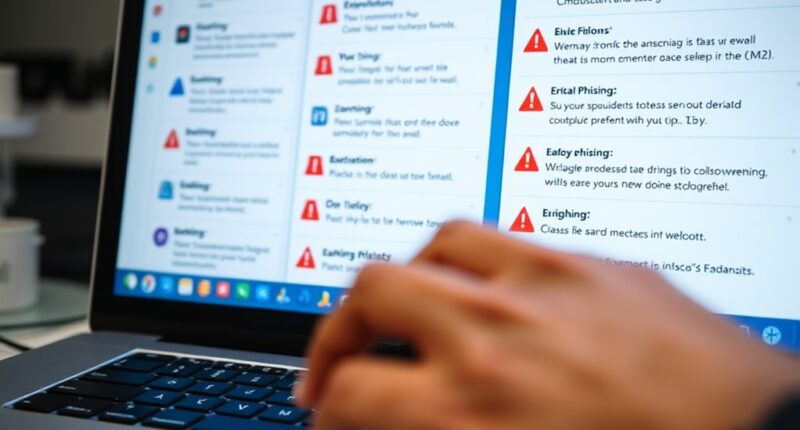Phishing emails are becoming more convincing, but you can spot them in just 30 seconds by taking simple steps. Hover over links to see their real destination, checking if they match the supposed sender’s website. scrutinize the sender’s address for misspellings or oddities, and look for URL errors or extra characters. If something feels off, don’t click or reply. Keep these tips in mind, and you’ll learn how to stay protected from smarter scams just ahead.
Key Takeaways
- Hover over links to verify if the URL matches the legitimate website before clicking.
- Check the sender’s email address for misspellings or suspicious variations.
- Look for slight misspellings or extra characters in email addresses and URLs.
- Pause and assess if the email’s tone or request seems unusual or urgent.
- Confirm suspicious requests through official website or direct contact with the organization.

Phishing emails are malicious messages crafted to deceive you into revealing sensitive information or installing malware. These scams have become more sophisticated, often mimicking legitimate organizations to trick even cautious users. One common tactic is email spoofing, where attackers manipulate the sender’s address to make it look like the email comes from a trusted source. This technique makes it harder to recognize a scam at first glance. Along with email spoofing, attackers embed malicious links within the email content. These links might appear harmless, but clicking them can lead you to fake login pages or automatically download malware onto your device. The key to avoiding falling victim lies in quickly identifying these red flags before any damage occurs.
A simple yet effective 30-second test can help you spot a phishing email. When you receive an unexpected email asking for personal or financial information, pause before clicking any links or opening attachments. First, hover over any links in the message without clicking. If the link’s URL doesn’t match the supposed sender’s domain or looks suspicious, that’s a major warning sign. For example, a legitimate company’s link will typically match their official website address, not a random jumble of characters or an unfamiliar domain. Be wary of URLs that spell out the company’s name with slight misspellings or extra characters, which are common in email spoofing attempts. Recognizing email spoofing techniques can greatly improve your ability to detect scams.
Next, examine the sender’s email address carefully. Even if it appears legitimate, look for subtle inconsistencies, such as misspelled domain names or unusual characters. Phishers often use email addresses that closely resemble official ones but aren’t identical. If the email asks for sensitive data, like passwords or credit card info, treat it skeptically—most legitimate organizations won’t request this information via email. Trust your instincts: if something feels off, don’t click or respond. Instead, go directly to the organization’s official website or contact their customer service through verified channels.
Frequently Asked Questions
How Can I Verify a Suspicious Email’S Sender Identity?
When verifying a suspicious email’s sender identity, start with email header analysis to trace its origin and check for inconsistencies. Look closely at the sender domain verification—ensure it matches the official domain of the supposed sender. Be cautious of misspellings or strange email addresses. These steps help you spot fake emails quickly, preventing potential scams or security breaches. Always double-check before clicking any links or sharing sensitive information.
Are There Specific Words That Commonly Indicate Phishing Attempts?
When you spot a suspicious email, pay attention to common scam words and phrases. Look out for urgent language like “immediate action required,” or threats such as “your account will be suspended.” Phrases like “click here” or “verify your information” can also be red flags. Recognizing these suspicious phrases helps you quickly identify potential phishing attempts, keeping your personal information safe from clever scammers.
What Are the Best Practices to Report Phishing Emails?
When reporting phishing emails, you should analyze the email header for suspicious activity and verify sender authentication techniques like SPF, DKIM, and DMARC. Forward the email to your IT or security team, avoiding clicking any links or downloading attachments. Use your email platform’s reporting features to flag it as phishing. This helps your organization take swift action and enhances overall email security.
Can Phishing Emails Bypass Spam Filters Easily?
You might wonder if phishing emails can bypass email filtering easily. While advanced threat detection improves email filtering, clever attackers craft messages that slip through filters by mimicking legitimate emails. To stay safe, rely on your instincts, scrutinize suspicious messages, and not just email filtering. Remember, even the best filters aren’t foolproof, so stay vigilant and question unexpected requests, especially those requesting personal information or urgent actions.
How Often Do Phishing Tactics Evolve to Become More Convincing?
You’ll notice that phishing tactics evolve constantly to become more convincing, often using sophisticated techniques like email encryption and malicious links to deceive you. Attackers adapt quickly, making their fake emails harder to spot. That’s why staying vigilant and learning quick tests helps you identify scams, even as scammers refine their methods. Regularly updating your knowledge and security measures keeps you one step ahead of these clever attacks.
Conclusion
To protect yourself from smarter phishing emails, always stay cautious. Check sender details carefully, hover over links before clicking, and look for spelling mistakes or unusual language. If something feels off, don’t rush—verify through official channels. Remember, scammers keep evolving, but staying alert and skeptical can save you from falling for their tricks. A quick 30-second test can make all the difference—so take that moment to verify before you act. Your security depends on it.









